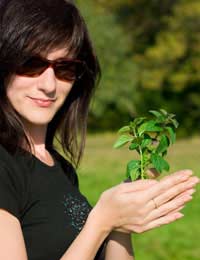Luckily, herb problems are rare. The plants do not usually suffer from pests that other plants can fall victom to Problems such as insect herb pests and diseases are rare and nutrient deficiencies are unlikely. Too much or insufficient watering can pose a problem, but this can usually be rectified easily. Another problem is the rate of growth of some herbs. Plants such as mint and lemon balm can take over the plot quickly and swamp the growth of other plants.

While they are rare, problems do occur from time to time so it’s important to know what to do if your herbs come into any difficulty.
Jump To...
Aphids and Other Insect Problems
Aphids are attracted to luscious leafy growth and can affect herbs such as basil and coriander. The most common aphids are greenfly or blackfly. These herb pests form clusters at the top of plants and around areas of new growth. They suck the sap from the plants and secrete a sticky sweet solution. Ants love to drink this solution, so you will often see them ‘farming’ aphids on plants and harvesting the sweet secretions.
As aphids are attracted to the lush, new growth of plants, they are more likely to attack plants that have been fed with artificial fertilisers. Artificial fertilisers cause lots of lush new growth and also weaken the plants’ ability to shrug off attacks from pests. What’s more, herbs fed with artificial fertilisers don’t taste as good as herbs allowed to develop naturally. As long as the soil is fertile and contains plenty of organic matter, there should be no need to provide additional nutrients.
If aphids attack your herbs the easiest way to remove them is to rub them off with your fingers or spray the infestation with a jet from your hose. You could also grow flowers such as candytuft and marigolds to attract ladybirds and lacewings to the area. They will happily feast on the aphids that are troubling your herbs. Don’t use pesticides. These are damaging to the plant and will end up on your plate!
For more information on pests and herbs, see ‘Controlling Pests’.
Herbs and Problems with Disease
Disease in herbs is extremely rare, but it can happen, especially during a warm, wet summer.
The following diseases can create herb problems:
- Chives – downy mildew and rust.
- Dill – phoma blight, rusty root, and stem rot have been reported.
- French tarragon – root rot in heavy and wet soils.
- Basil – powdery mildew
- Oregano – root rot.
Problems Growing Herbs
Most herbs get on quite happily if placed in a sunny position in fertile, free draining soil. However sometimes they will grow too much or not grow enough.
Herbs that can invade the plot include mint and lemon balm. They can take over the plot and inhibit the growth of other herbs in the plot. To avoid this, grow them in pots and sink the pots into the soil. This will restrict their root growth and prevent them from spreading where they’re not wanted.
Other problems that affect growth of herbs include:
- Insufficient light – most herbs require plenty of sunlight to thrive. Try moving your herbs to brighter areas.
- Water logging – if you have heavy clay soil water can have difficulty draining away, especially when it has been raining for a prolonged period. Break up the soil by adding plenty of organic matter, such a compost or well-rotted manure and grit. Alternatively, grow the herbs in a soil-based compost in a pot.
- Nutrient deficiency – if the leaves of your herbs appear yellow or brown at the ends and the soil isn’t too dry or too wet, there might be insufficient nutrients n the soil. Apply an organic liquid feed to give the plant a boost, then add organic matter such as compost or well-rotted animal manure in autumn to provide nutrients for next season.
- Running to seed – annual herbs such a coriander and basil can be probe to running to seed in hot weather. This means that, rather than producing lots of luscious leaves, they start flower production early and develop seeds, which slow or stop the growth of new leaves. This can be brought on by a variety of factors, including stress. The most common is high temperatures. Grow the plants in slightly shady areas to prevent this from happening.
It is unlikely that your herbs will encounter any problems. However when they do, it’s important not to panic. Pests will be eaten by predators such as ladybirds and lacewings, and annual herbs can be re-sown – they’ll be ready in a few weeks.

Hi, my herbs in the garden (Not in pots) are a worry. Fennel is about 5 feet high and going to seed, do I cut it back ?. Corriander, Oregano and Dill the same, do I cut that back ?. The Parsley, both in the garden and in pots, is tuning yellow, too much/little water ?, or is it lack of nitrogen ? Sorry for the many questions but I don’t want to lose the plants. Your help would be much appreciated. JB
Hi I have been growing coriander on my window sill for approx 5/6 weeks and it is still very spindly and on a few decent leafs on…is this normal or should they be more ‘bushy’ by now. I am a complete novice to growing anything so any advice would be appreciated! Thanks in advance
I have grown herbs for many years with great success. But last year, I had a terrible problem with my basel and it’s starting again this year, also,affecting other herbs. I can’t see any insects on the pants. The new growth is covered with small black dots and the leaves are shrinking. I am now seeing some on the oregano and mint too. What can I do to identify and treat this?